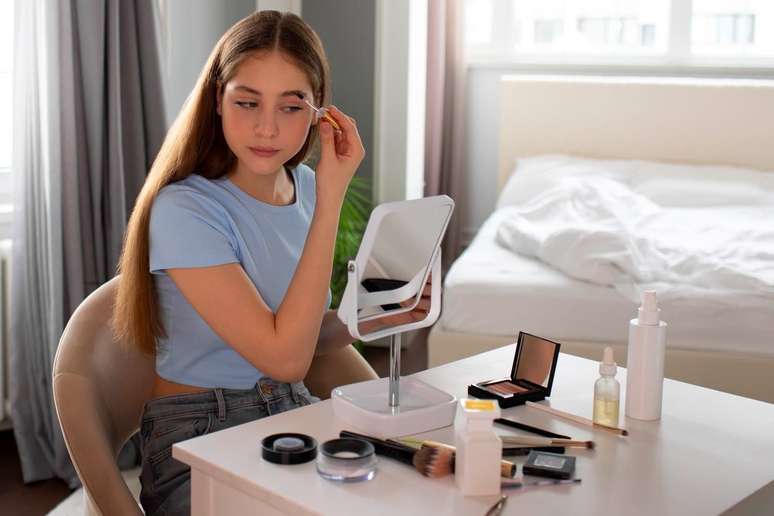Children and teens are investing in anti-aging skincare early, in a phenomenon that’s been dubbed the “Sephora Kids”
It is normal to associate skin with beautification, but skin tissue has very specific functions, the main one being the formation of a protective barrier. This concept is increasingly being forgotten in the name of anti-aging treatments promulgated on social media and the problem is that children, adolescents and young people are ignoring this main function of the skin, in the name of beauty and the prevention of aging which is still very difficult, investing obsessively in anti-aging treatments that can cause more harm than good in these age groups.
“We have observed the trend in the consumer market of children and pre-teens, aged 9 to 14, consuming inappropriate skin care products, often influenced by bloggers and influencers, who promote products inappropriate for their age patients. This quest is influenced by an incessant pursuit of perfect appearance and eternal youth. This fashion hides significant risks for the health and well-being of young skin”, warns dermatologist Claudia Marçal, member of the Brazilian Society of Dermatology.
At the same time, young people between 18 and 24 want to be one step ahead and creams no longer count: they resort to Botox.
“In this age group, it is common that, influenced by social media, they come to the office certain that they want to undergo, for example, an application of botulinum toxin. But in general they have no indications, they are still very young, there is no need. The risks of starting this treatment too early are not clear, but smaller studies have shown that there is the possibility of producing antibodies, causing this patient not to respond to botulinum toxin in the future. In addition, of course, to the waste of money, time and a frozen appearance”, adds dermatologist Paola Pomerantzeff, member of the Brazilian Society of Dermatology.
beauty standards
Beauty standards are once again at the center of the debate, but why are children, adolescents and young people so worried about eternal youth?
“In the Western world, beauty is synonymous with youth, magazine covers feature young people, faces without a shadow of wrinkles, thin women with makeup and not to mention Photoshop. Hips, flat stomach, wrinkles, everything is a disease, it must be treated at all costs”, asks plastic surgeon Beatriz Lassance, member of the Brazilian Society of Plastic Surgery.
“Even more alarming is the possibility that the continued use of anti-aging products by children, adolescents and young people contributes to a distortion of self-image and perception of beauty. The pressure to prevent the signs of aging before they even appear can reinforce unattainable ideals of aesthetic perfection, negatively impacting self-esteem and psychosocial development,” underlines Claudia Marçal.
The social network – that, always the same
Editing photos for publication is nothing new: on the social network everything must be perfect. But you know the idea of #nofilter, where people claim to post “candid” photographs of their unfiltered faces? It made more “noise” than it actually appeared. A University of London study suggests that up to 90% of people edit their selfies before posting them. And children and young people are exposed to this type of content.
“It is necessary to know how to critically analyze images on social media. Learn to always be wary of what you see, it could be the pose in which the photo was taken, Photoshop, the filters, even the light of the exposure can favor the photo”, explains Beatriz Lassance.
In a study published in 2023, participants who edited their photos were more likely to rate themselves as less attractive. They also engaged in what theorists call self-objectification: internalizing what an outside observer might think of their appearance, rather than prioritizing their own self-image. This is associated, according to the work, with body shame, eating disorders and mood disorders, such as depression.
“The obsession with beauty negatively affects mental health and is affected by it,” emphasizes Beatriz Lassance.
Feel it on your skin
This whole trend, like “Sephora Kids”, is not harmless. The skin of children and adolescents is already characterized by elasticity, firmness and natural regenerative capacity, which in themselves would not require products suitable for these purposes; But children’s skin has different needs than that of adults.
“Even in this age group, the skin is very thin and sensitive, its barrier function is not 100% formed, as it is in adults or adolescents who have already gone through all the hormonal changes. The application of anti-aging products, formulated to combat wrinkles, fine lines and other signs of aging, could not only be useless, but also harmful for this audience. The active components of these products are substances such as retinoids, acids and antioxidants in high concentrations. These substances can hurt, burn and photosensitize the skin, causing spots and dermatitis. These patients can also develop acneiform rashes and allergies; there is also a process of change in the skin microflora, with hypersensitivity, which predisposes to future problems”, warns Claudia Marçal.
The worst thing is that many children and adolescents induce a skin problem, acne, in this case cosmetic, precisely in an age group in which they are more susceptible to the disease.
Exaggerations and artificial results
In general, young people have a misinterpretation of the idea of anti-aging products and treatments and often believe that it is necessary to fear aging – and fight it.
“Anti-aging or anti-aging does not exist. If all goes well, we will age a lot. The percentage of elderly people is increasing all over the world. There is a movement called pro-aging, which advocates healthy aging instead of trying not to age or to reverse the signs of aging. In aesthetics, there is a concern to change the concept that elderly people are ugly. The elderly population is increasingly economically active, the current 50 are called the old 30. The search for beauty must correspond to the beauty of each age”, assures Beatriz Lassance.
And this rush among young people to get cosmetic treatments can have discouraging results. With this wave of information about prevention on social media, some may try to start, for example, with botulinum toxin earlier, because they see it as a preventative treatment.
“Therefore, patients think that starting in their 20s the procedure would serve to prevent even more wrinkles, which may not be confirmed if the patient does not really have an indication for it. It is worth remembering that we have other factors to consider in the prevention and management of aging, including a decrease in fat compartments and a decrease in collagen production,” explains Paola Pomerantzeff.
In general, the indication of botulinum toxin with preventive application is carried out starting from the age of 25. “Before that it is rarer, but we must evaluate the individual needs of the patient,” adds the dermatologist.
Injectables may be a young person’s first stop in aesthetic procedures. But starting fillers too early, depending on the case, can accelerate the aging of the appearance.
“This frequent, repeated and inappropriate use of these substances, over time, increasingly stretches the tissues, thus creating the need for more and more fillers and, therefore, worsening the signs of aging,” explains the plastic surgeon, who is in no way against the use of this filler – which she considers a valuable tool if properly indicated.
“We have been able to restore deep structures such as bones, replace lost fat compartments, improve the proportion of facial structures and even improve the quality of the skin. The problem lies in the diagnosis and in the indication of when, how and if it is necessary to fill it in,” explains Beatriz Lassance.
What makes sense at each age?
But that doesn’t mean that children, teenagers and young people can’t take care of their skin.
According to Claudia Marçal, as with children, it is essential that parents, guardians and educators are aware of these trends and talk openly with children and adolescents about the importance of adequate skin care.
“The use of skin care products can be recommended, depending on the age, by the pediatrician or dermatologists. And we have many varieties within industrialized brands or through customization at the compounding pharmacy. Contrary to what is propagated by information on social media, the pillar for the skin of a teenager is a basic care routine,” says the doctor.
“This includes: a good soap, preferably neutral, which can be formulated to control oiliness, to be used twice a day, morning and evening; a cleansing solution or micellar solution to complete this hygiene; a serum-based, watery, light moisturizer, rich in substances that retain water in the skin; and a sunscreen indicated mainly for the adolescent age group. And in the evening, in addition to washing and cleansing, use a moisturizer before bed, and if acne forms, the doctor may recommend localized drying agents, which are based on salicylic acid, benzoyl peroxide and adapalene,” comments Claudia.
In the case of young people, Paola warns: “You need to consult a dermatologist. As with everything in medicine, you need to examine the patient, make a correct diagnosis and only then decide which treatment is most appropriate. In some cases, to calm the patient’s desire and, at the same time, offer a truly effective treatment for this skin, we can recommend technological treatments, which will favor an improvement in the quality, health and appearance of this skin with very satisfactory results. “, says the dermatologist.
«This is done with the Thulium laser, which acts on the superficial layer of the skin tissue in a less aggressive way. This laser has a high affinity with the water present in the skin, promoting controlled damage that stimulates cell renewal and the production of collagen and elastin, as well as breaking down the melanin that causes imperfections”, concludes Paola Pomerantzeff.
inspires transformation in the world of work, in business, in society. Compasso, a content and connection agency, is born.
Source: Terra
Ben Stock is a lifestyle journalist and author at Gossipify. He writes about topics such as health, wellness, travel, food and home decor. He provides practical advice and inspiration to improve well-being, keeps readers up to date with latest lifestyle news and trends, known for his engaging writing style, in-depth analysis and unique perspectives.








